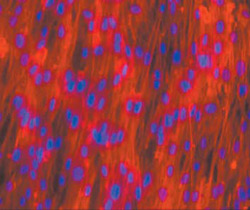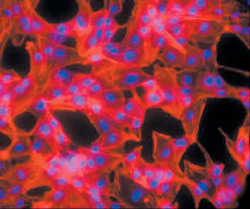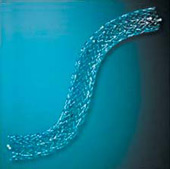| 2005 |

|
YEAR BOOK |
University College Dublin
|
A good heart these days is hard to find
|
Cardiovascular disease claimed 10,984 lives and was responsible for 39% of all deaths in Ireland in 2003 making it the biggest killer amongst Irish people (Central Statistics Office, 2004). Coronary artery disease (CAD) is the main form of cardiovascular disease and is the single leading cause of death in the western world. This condition occurs when the coronary arteries, which supply the heart with oxygenated blood, become blocked due to the formation of a fatty plaque (atherosclerosis) within the artery wall. As a result, oxygen supply to the heart is compromised and can result in angina or heart attack. One of the main treatments of CAD is balloon angioplasty. This procedure involves the insertion of a wire (catheter) with a balloon tip into an artery in the leg. The wire is guided through the arteries back to the coronary arteries where at the point of blockage the balloon tip is inflated. This compresses the plaque against the vessel wall. The balloon tip is then deflated and the wire is removed. Blood flow is restored to the heart.
Unfortunately, our arteries are much like elastic bands and often snap back to their original size not long after the balloon has been deflated and removed. This renarrowing of the artery is known as "restenosis" and occurs in approximately 30-50% of all patients who undergo angioplasty. Stenosis of a vessel means blockage of the vessel, so restenosis is the re-blockage of the vessel. For this reason stents (wire-mesh tubes) are often inserted into the vessel wall, attached to the outside of the balloon and remain there permanently to act as a scaffold for the vessel. Stents are made of material not unlike chicken wire, in the sense that they are flexible by nature and can be mounted over the balloon in a collapsed state. At the point of blockage, as the balloon is inflated, the stent is expanded. The balloon is then deflated and removed leaving the stent in place.


Drugs, however, will not easily stick onto the metal stent surface. Instead, the stent can be covered with a special coat that acts much like a sponge and can soak up the drug and release it over time. In my project, I have been testing the ability of a number of such coats, which are novel polymers, to soak up a drug called fluvastatin and release the drug over time.

In summary, my project investigates the potential of fluvastatin, delivered locally from the stent surface, to prevent renarrowing of vessels after angioplasty and stenting.
*Fiona Mc Gillicuddy, Conway Integrative Biology, won third prize in AccesScience '05; a competition for 3rd year postgraduate students held in UCD in March 2005. This is a summary of her presentation.
k>
Contact: Fiona McGillicuddy, Department of Pharmacology,
Conway Institute, UCD, Belfield, Dublin 4;
Tel: (01) 7166838; E-mail: [email protected]